Occupational environment monitoring at an essential oil manufacturing factory
99,000 ₫
Note: The above price is calculated for one sample, and the price may fluctuate depending on the area of the environment to be monitored and market movements. For more accurate pricing support, please refer to the price list or contact our consulting staff directly.
Monitoring the environment of an essential oil production factory is a session of collecting, analyzing, and evaluating workplace factors that may be harmful to workers’ health.
Table of Contents
Toggle1. Overview of Essential Oil Factory
a. What is an essential oil factory?
Factory producing essential oils is a facility where essential oils are extracted from natural resources such as plants, fruits, seeds, herbs, roots, or branches. The essential oil production process usually includes stages such as raw material harvesting, extraction, refinement, filtration, and packaging.
An essential oil factory may produce oils from a specific plant or from various raw materials depending on the intended use and market demand. Essential oils are widely used in industry, medicine, cosmetics, food, and other sectors for purposes such as health care, beauty, aromatherapy, and flavoring.

b. Production stages in an essential oil factory
The production stages in an essential oil factory may include:
- Harvesting: This is the process of collecting natural raw materials such as plants, fruits, seeds, roots, or branches. Materials are usually selected when they have an appropriate oil content and high quality.
- Extraction: This stage separates essential oils from the raw materials. Extraction methods may use heat, pressure, chemical solvents, or mechanical techniques such as pressing or cold pressing. The goal is to extract the oil without losing important constituents.
- Refinement: Extracted oils may undergo refinement to remove impurities and enhance quality. This process may include filtration, crystallization, aeration, or other methods to purify and enhance the properties of the oil.
- Quality control: After refinement, essential oils need to be tested to ensure compliance with chemical composition, fragrance, and other properties. Typical checks include chemical analysis, scent evaluation, transparency inspection, and other quality criteria.
- Packaging: After quality inspection, essential oils are packaged in appropriate containers such as bottles, jars, or flasks. Packaging must ensure safety and proper storage, protecting the oils from sunlight, heat, and environmental factors.
- Labeling and shipping: Finally, the essential oil products are labeled with information on ingredients, usage instructions, and safety warnings. They are then shipped to consumers or other clients.

c. Machinery used in an essential oil factory
Various machines and equipment are used in essential oil factories. Common types include:
- Press machines: Used for hot or cold pressing of raw materials to extract oils. These can be hydraulic presses, screw presses, or rotary presses.
- Concentration machines: Used to remove excess liquids and concentrate essential oils, enhancing their quality and potency.
- Filter machines: Used to remove impurities and separate oils from waste materials. Types include pressure filters, vacuum filters, or oil filters.
- Steam machines: Provide heat and steam for processes such as extraction and refinement.
- Cooking machines: Used for boiling and distilling raw materials to produce necessary vapors and liquids for oil production.
- Packaging machines: Used to package oils into suitable containers like bottles, jars, or flasks. Machines may include capping machines, labeling machines, or automatic packaging systems.
- Quality control machines: Used to test quality indicators such as boiling point, transparency, additive content, and other chemical properties.

d. Occupational diseases for workers in essential oil factories
Workers in essential oil factories may encounter the following occupational diseases:
- Respiratory diseases: Exposure to essential oil vapors, gases, or dust may irritate or damage the respiratory system, causing pneumonia, asthma, sinusitis, and other respiratory problems.
- Skin diseases: Contact with essential oils and chemicals during production may cause skin irritation, dermatitis, eczema, and other skin issues.
- Eye diseases: Essential oil exposure can cause tearing, irritation, and eye inflammation. Contact with chemicals during production can also pose eye hazards without proper protection.
- Digestive diseases: Exposure to chemical compounds in essential oils may irritate or harm the digestive system, leading to ulcers, enteritis, or other digestive disorders.
- Nervous system disorders: Some compounds in essential oils may affect the nervous system, causing dizziness, headaches, insomnia, and mental disturbances.
- Pre-chronic and chronic conditions: Workers in high-pressure, long-duration, and stressful environments may develop psychological issues such as stress, fatigue, sleep disorders, and depression.
To protect the health of workers in essential oil factories, occupational safety measures, personal protective equipment, safe work processes, and compliance with environmental regulations must be applied.

e. Popular essential oils in the market
There are many popular essential oils available on the market, including:
- Peppermint oil: With a refreshing aroma, often used to relieve pain, reduce stress, and boost energy.
- Lavender oil: Herbal and gentle scent, used for relaxation, stress relief, and improving sleep quality.
- Lemon oil: Fresh and zesty scent, used for cleaning, deodorizing, and refreshing.
- Tea tree oil: Antibacterial and antimicrobial properties, used in skincare, haircare, and cleaning.
- Chamomile oil: Mild fragrance, used for relaxation, soothing skin, and promoting sleep.
- Ginger oil: Spicy and warm scent, used for muscle pain relief and deodorizing.
- Grapefruit oil: Fresh aroma, used to energize, refresh, and reduce stress.
- Patchouli oil: Earthy and warm scent, used in skincare and perfumes.
2. Overview of occupational environment monitoring services
a. What is occupational environment monitoring in essential oil factories?
Occupational environment monitoring (or workplace environment measurement) in essential oil factories involves collecting, evaluating, and analyzing measured indicators of workplace environmental factors. The goal is to implement timely measures to reduce environmental impacts on workers’ health and prevent occupational diseases. Occupational environment monitoring is a mandatory requirement for essential oil factories.
Monitoring plays a crucial role in protecting and promoting workers’ health because employees are the main resource and directly generate profit for enterprises. Workers frequently exposed to risk factors and occupational hazards beyond permitted levels may suffer health issues and occupational diseases.
REGISTER FOR OCCUPATIONAL ENVIRONMENT MONITORING SERVICE
b. An Toan Nam Viet’s occupational environment monitoring program
An Toan Nam Viet’s occupational environment monitoring program is developed by monitoring engineers in occupational safety and environmental protection. Aiming to ensure worker health and safety, the program uses modern measurement methods to monitor air, water, and microclimate, physical, and dust factors in the workplace. This program is crucial to ensuring a safe working environment and protecting workers’ health.
Moreover, An Toan Nam Viet’s monitoring program is important for researching and developing new solutions to improve workplace environmental quality. With the dedication and professionalism of its experts, An Toan Nam Viet’s exclusive monitoring program is a breakthrough in occupational safety and environmental management in Vietnam.

c. Standardization in workplace measurement procedures
Standardization in An Toan Nam Viet’s workplace measurement procedures is essential for ensuring result quality. To ensure accuracy and reliability, the program follows recognized standards and procedures from the Ho Chi Minh City Department of Health. This guarantees that collected data are reliable for evaluating workplace environments and making informed decisions to protect workers’ health.
These standardized procedures also ensure that measurements are conducted by highly skilled monitoring specialists with years of experience, allowing managers and experts to trust An Toan Nam Viet’s results and make accurate, valuable decisions for health and environmental protection.
By applying standardized measurement procedures, An Toan Nam Viet demonstrates its commitment to a safe working environment and worker health, while contributing positively to improving occupational safety and environmental management in Vietnam.
d. Reporting results of essential oil factory monitoring
Monitoring results are prepared according to Form No. 04, Appendix III issued with Decree 44/2016/ND-CP and made in two copies: one sent to the contracting workplace and one retained by the monitoring organization.
The retention period of occupational environment monitoring results is indefinite according to legal regulations.

e. Frequency of occupational environment monitoring according to law
According to Clause 2, Article 18 of the Law on Occupational Safety and Health 84/2015/QH13, employers must conduct occupational environment monitoring to assess harmful factors at least once a year.
f. Deadline for submitting occupational environment monitoring reports
The deadline for submitting reports is before December 31 each year. Enterprises in production facilities are required to submit monitoring reports to the local Department of Health where the factory is headquartered and where employees work.
When there are changes in technology, production processes, or renovations/upgrades that may generate new harmful factors affecting workers’ health, enterprises must update occupational hygiene records related to factors requiring monitoring.
g. Penalties for violations of occupational environment monitoring by employers
According to Article 27 of Decree No. 12/2022/ND-CP dated January 17, 2022, regulating administrative penalties in labor, social insurance, and Vietnamese workers working abroad under contract:
- Clause 2: Fines from 2,000,000 – 5,000,000 VND for employers who fail to publicly inform employees at the monitoring site and the evaluated site immediately after receiving monitoring results and hazard evaluation outcomes.
- Clause 3: Fines from 20,000,000 – 40,000,000 VND for employers who do not conduct occupational environment monitoring to control health risks according to the law.
- Clause 4: Fines from 40,000,000 – 60,000,000 VND for employers who collude with monitoring organizations to commit fraud in monitoring activities, but not to the level of criminal liability.
3. Harmful Environmental Factors for Workers in Essential Oil Factories
Workers in essential oil factories may be exposed to several harmful environmental factors. Below are some potential hazards that could affect workers:
- Organic vapors: The essential oil extraction process may generate organic vapors from chemicals such as solvents and additives. Organic vapors can irritate the respiratory system, cause headaches, dizziness, and difficulty breathing.
- Chemical vapors: During production, chemicals such as solvents, cleaning agents, and additives may be used. Exposure to these vapors can cause irritation to the skin, eyes, respiratory system, and digestive system.
- Dust: Handling and processing essential oils can generate dust from raw materials and additives. Dust can irritate the eyes, respiratory tract, and skin.
- Noise: Machinery and equipment in essential oil factories can generate high noise levels. Continuous and loud noise can harm workers’ hearing.
- Temperature and humidity: Some production processes may require specific temperature and humidity conditions. Working in excessively hot or humid environments can cause discomfort, fatigue, and reduced work efficiency.
- Additives: During production, additives such as colorants, thickeners, and preservatives may be used. Long-term exposure can cause skin irritation, allergies, and affect health.
REGISTER FOR OCCUPATIONAL ENVIRONMENT MONITORING SERVICE
4. Measures to Improve the Working Environment in Essential Oil Factories
To improve the working environment in essential oil factories and protect workers’ health, the following measures can be applied:
- Ensure ventilation and extraction systems: Install effective ventilation to clean factory air and dust extraction systems to reduce exposure to dust and organic vapors.
- Use personal protective equipment: Ensure workers are fully equipped with PPE such as masks, gloves, safety goggles, air suction devices, chemical protective clothing, and safety shoes. Ensure proper use and maintenance of protective equipment.
- Training and education: Provide workers with training and education on occupational safety, PPE usage, safe working procedures, and waste handling. Ensure workers understand hazards and prevention measures to avoid accidents and occupational diseases.
- Waste management: Safely and legally handle and dispose of production waste according to environmental regulations and standards. Ensure proper storage, transport, and disposal to prevent environmental pollution and harm to workers’ health.
- Noise control: Apply noise control measures such as acoustic barriers, isolation, or noise control panels to reduce noise from equipment and processes.
- Temperature and humidity control: Maintain comfortable temperature and humidity in the workplace using air conditioning and temperature control systems.
- Regularly conduct occupational environment monitoring in factories, collect and analyze harmful factors, and implement adjustments to reduce hazards and prevent occupational diseases for workers.
5. Benefits of Periodic Essential Oil Factory Environment Monitoring
An Toan Nam Viet provides businesses with excellent benefits when using occupational environment monitoring services according to Decree 44/2016/NĐ – CP on the management and control of harmful factors in the working environment affecting workers.
- Businesses can proactively control harmful factors in workshops or factories.
- Receive advice and recommendations to minimize harmful factors and improve workplace environmental quality.
- Indirectly protect human resources, the key factor in business development.
- Reduce the impact of occupational diseases on health, minimizing future medical costs.
- Improved worker health leads to higher product quality and ensures consistent production output.
- Comply with labor safety regulations and avoid legal risks.
- Enhance credibility and professionalism, elevating the company’s brand.
An Toan Nam Viet’s environment monitoring service is a solution to reduce occupational disease risks, contributing to a clean and high-quality working environment.

6. Nationwide Occupational Environment Monitoring Center
An Toan Nam Viet Occupational Environment Monitoring Center is a professional unit for supervising and measuring occupational environment quality across all provinces in Vietnam. With experienced monitoring specialists, the center uses modern measuring equipment to ensure accuracy and reliability.
In addition to monitoring services, the center supports clients in planning, handling, and tracking occupational environment issues. With the motto “customer-centric,” the center prioritizes client satisfaction and provides optimal solutions for businesses.
REGISTER FOR OCCUPATIONAL ENVIRONMENT MONITORING SERVICE
With investments in technology, equipment, and workforce, An Toan Nam Viet’s monitoring center has become a reputable unit in occupational environment monitoring in Ho Chi Minh City with the following objectives:
- We value our brand reputation and service quality.
- We provide clients with the best and most suitable solutions.
- Alongside experienced Masters and Engineers, aiming to protect the environment and benefit businesses.
- Clients using An Toan Nam Viet monitoring services receive professional support from experts and the best cost advantages.
The occupational environment monitoring process at An Toan Nam Viet includes the following steps:
- Before monitoring, ensure all equipment is calibrated according to legal regulations.
- Follow the committed occupational environment monitoring procedures with the Department of Health.
- Report monitoring results truthfully to employers.
- If results indicate unsafe conditions, An Toan Nam Viet will support remediation measures and the workplace will:
- Implement measures to improve working conditions, minimizing harmful factor exposure and preventing occupational diseases.
- Organize health check-ups to detect occupational diseases early for workers in unsafe positions.
- Provide material compensation to workers according to labor law regulations.

7. Occupational Environment Monitoring Pricing
To help businesses conduct professional and effective occupational environment monitoring, An Toan Nam Viet provides a detailed price list for monitoring services with quality and reasonable costs.
- Our price list provides detailed information on all monitoring services offered, including costs for travel, measurement, analysis, and reporting. Clients can trust the accuracy and reliability of our monitoring reports.
- We commit to offering competitive and reasonable prices, while providing fast and professional consultation for all monitoring service inquiries.
- With An Toan Nam Viet’s monitoring price list, clients can easily select service packages suitable for their needs, ensuring maximum satisfaction with professional service quality.
No comments yet

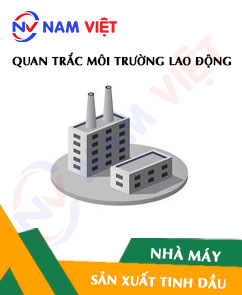
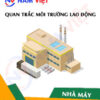
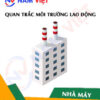

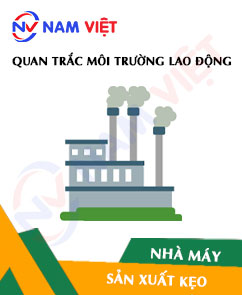





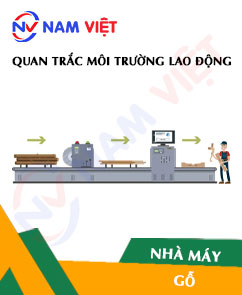
Review Occupational environment monitoring at an essential oil manufacturing factory
There are no reviews yet.